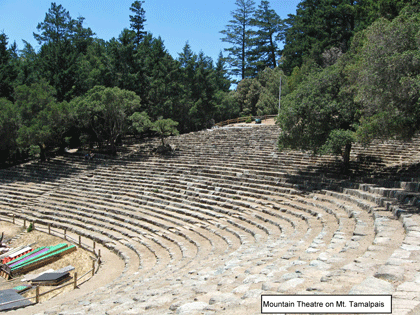
One of the current projects in the office requires an amphitheater. In Roman times, an amphitheater was considered two theaters facing each other with a stage in the middle. The Roman Coliseum is a good example of this. Today it simply means an outdoor theater with a stage and places to sit and a place for vendors to provide food and drink. With this initial knowledge, I went looking for design elements of amphitheaters.
I searched the web and found some great photos. One of the best was the Scott Outdoor Amphitheater at Swarthmore College in Pennsylvania. It was designed by Thomas W. Sears, a landscape architect, and built in 1942. Then, I went to the library and found the 4th edition of ‘The Oxford Companion to the Theatre.’ This book lists several definitions about the theater. Under the acoustics heading, several physical elements that enhance sound distribution were explained. This reading brought me back to the internet where I found an article about the outdoor theater in Epidaurus, Greece. Live Science. Finally, I reviewed the outdoor venues I have visited and what made them enjoyable.
The most fascinating item I found was that the outdoor theater in Epidaurus, Greece, which was built about 4 B.C., is one of the best theatres for sound distribution. Recently they have determined that it is not just because of the semicircular seating or the incline angle of the seats, it also has to do with the material of the seats. They were built with limestone. Turns out the limestone absorbs low frequencies like the whispers of the crowd and reflects the higher frequencies of the performers’ voices. If the performers have some low frequencies here and there in their speech, ‘The Oxford Companion’ explains the human mind has the ability to fill in these lower sounds and understand the dialogue.
A few other physical elements to enhance sound include a backdrop, a ceiling and a lowered front floor. The backdrop stops the sound from leaving out the back of the stage. The ceiling over the stage keeps the sound from going up into the sky. A solid floor in front of and a bit below the stage bounces the falling sound back into the audience. In an indoor theater, it is known that a smooth wall will bounce around sound from the performers and the audience members over and over. This will amplify and echo the sounds and disrupt the listener’s experience. These indoor walls need an absorptive quality. Many times you will see tapestries or ornate wood carvings on the walls and ceilings. These elements capture the sound and keep them from becoming an echo. If the elements are too absorptive, the sound will be muffled to the extreme and again lessen the listener’s experience.
Today there are speakers to help with the sound distribution. They come in all sizes and range of frequencies. Depending on the size of the audience, an experienced sound engineer / sound technician will set up a speaker or multitude of them. They will be set right at the stage and/or spread throughout the audience. Either way, the sound engineer has the ability to test the set up and adjust them for any echo or feedback that screeches through.
A good example of the use of speakers is in the lawn seats at Ravinia. This outdoor venue just outside Chicago, IL is a popular spot. The Chicago Symphony and other performers play through out the summer. There is permanent seating around the stage that is arranged in an arc and built with a slight incline. This is the pavilion and it has a roof, but the sides are open. The sound is distributed throughout the seating area and into the surrounding lawn area with the use of speakers. The lawn area allows for less expensive seating. However, several of the people with pavilion tickets come early, sit in the lawn with their picnic and then enter the pavilion at their leisure. The ticket holders for the lawn come as soon as the gates are open, stake claim to their spot with blankets and tie balloons or banners so others in their party can find them. After their meal, the audience in the lawn quiets, stretches out on their blanket and watches the stars brighten as the music lingers in the air.
Here in Grass Valley, the Nevada County Fairgrounds has a large lawn area where the audience sets up their own chairs in front of the temporary stage. I have not been there early enough to see this happen but they must have a chair alignment police to make such a nice arrangement. I have been told that if the owners of the chairs are not watching the current performance, one can go sit in the chairs until the owner returns. I have not tried this. Nor do I think I would be comfortable trying it unless I knew the person who owned the chair. I would also prefer to lie on a blanket and watch the tips of the trees sway in the summer breeze and find formations in the clouds as the music dances by my ears.
The design required for our project will be completed in phases, with a current budget allowing for a small stage and lawn seating. Future phases, and a generous donor, would allow the design elements of the great outdoor theatres to be incorporated into this space. This would include designs for permanent seating, set on an incline and built with stone (with cushions for modern comfort). In addition to the historic elements, an open area is a required design element. This will allow the audience to spread out on a blanket, enjoy good company and relax while watching the sky and as the music floats by their ears.
Elizabeth Dunn is a licensed Landscape Architect. She spends the majority of her work days in the studio of Rebecca Cofffman Landscape Architects in Nevada City, CA